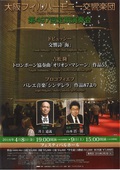


ドビュッシー : 交響詩「海」 吉松 隆 : トロンボーン協奏曲「オリオン・マシーン」Op.55/山本浩一郎[Tb] プロコフィエフ : バレエ音楽「シンデレラ」 Op.87より 大阪フィルハーモニー交響楽団
For a long time, I’ve kept proposing that the Osaka Philharmonic Orchestra, nurturing their Bruckner performance legacy, should also demonstrate their ability with more friendly and accessible music. Western European composers’ works for example, as the orchestra is a mirror reflecting the characters of Osaka and its people. That’s how the first subscription concert of the new season was programmed.
Today’s three pieces proved how great the Festival Hall really is.
Opening a concert with “La Mer” by Debussy was one of the hardest choices, because, contrary to Ravel, Debussy’s orchestration sounds foggy. With his music, we have to seduce the audience members who enter the hall from the quotidian world full of different noises. They are then obliged to stand at the beach immediately before they can even “change into their swimsuit”. In such situations, mermaids appear abruptly, and they would look like Cosplay geeks…
In actual reality, the criteria for having a successful concert or not would depend on not only the interpreters’ conditions, but also how the audience is seated and which feeling they have right before the music comes to them.
“Tonight, X Symphony Orchestra started out quite clumsily, then they, however, began to sound better gradually”… we frequently find such pattern in concert reviews, but this is in fact is because the reviewers’ ears took some time to get accustomed to the sound.
Today I found a lot of expertise in the wind sections and the trumpet player was amazing.
As for the Concerto for Trumpet “Orion Machine” by Takashi Yoshimatsu, we had the orchestra set in shape similar to the Cygnus constellation after the fashion of his other piece “Threnody to Toki”, but not the Orion form.
The key to performing the piece is the technique and personality of the soloist, and Mr. Yamamoto gave his cadence heartily, with a “planned spontaneity” in a more interesting way on the second day. During the dress rehearsal of the second day, I tried to focus him on practicing this cadence, but orchestral members seemed to be wondering why they had to spend their time for such thing… Well, sometimes conductors have to do something, even if they cannot fully explain why.
We performed the Suite from Prokofiev’s ballet “Cinderella” (ash girl!) for the last half of the concert. Compared to the existing suite edited by Prokofiev, my “highlights” version follows the order of the story, so I flatter myself that the audience could understand clearly what each excerpt describes.
Recently, the string section of the Osaka Philharmonic Orchestra has been becoming large-scale. Still, the acoustic gap between the rehearsal studio and the hall is really a headache, not only for me but for everyone!
By the way, I am wondering if the glass slipper of Cinderella is in fact a metaphor of “an invisible filter” that the man (the prince) owns without knowing it, or another way to think of it is, “his own world”… I mean, instead of being “a firm, unwearable shoe”, couldn’t it be an invisible filter?
2025年1月 1
2024年12月 4
2024年11月 7
2024年10月 4
2024年9月 3
2024年8月 1
2024年7月 2
2024年6月 7
2024年5月 8
2024年4月 5
2024年3月 4
2024年2月 7
2023年12月 4
2023年11月 1
2023年10月 3
2023年9月 1
2023年8月 3
2023年7月 2
2023年6月 5
2023年5月 5
2023年4月 2
2023年3月 3
2023年2月 1
2023年1月 3
2022年12月 7
2022年11月 3
2022年10月 1
2022年9月 3
2022年7月 4
2022年6月 1
2022年5月 6
2022年4月 3
2022年3月 6
2022年2月 5
2022年1月 5
2021年12月 4
2021年11月 5
2021年10月 4
2021年9月 3
2021年8月 2
2021年7月 5
2021年6月 6
2021年5月 3
2021年4月 2
2021年3月 5
2021年2月 3
2021年1月 3
2020年12月 5
2020年11月 3
2020年10月 4
2020年9月 2
2020年8月 2
2020年7月 4
2020年6月 2
2020年4月 3
2020年3月 5
2020年2月 1
2020年1月 2
2019年12月 3
2019年11月 4
2019年10月 2
2019年9月 3
2019年8月 2
2019年7月 5
2019年6月 5
2019年5月 5
2019年4月 4
2019年3月 5
2019年2月 4
2019年1月 3
2018年12月 6
2018年11月 3
2018年10月 4
2018年9月 4
2018年8月 1
2018年7月 1
2018年6月 3
2018年5月 5
2018年4月 4
2018年3月 8
2018年2月 12
2018年1月 6
2017年12月 11
2017年11月 4
2017年10月 6
2017年9月 9
2017年7月 6
2017年6月 4
2017年5月 7
2017年4月 2
2017年3月 4
2017年2月 4
2017年1月 2
2016年12月 6
2016年11月 8
2016年10月 1
2016年9月 2
2016年8月 3
2016年7月 8
2016年6月 4
2016年5月 8
2016年4月 5
2016年3月 4
2016年2月 5
2016年1月 5
2015年12月 8
2015年11月 5
2015年10月 6
2015年9月 11
2015年8月 2
2015年7月 3
2015年6月 8
2015年5月 5
2015年4月 6
2015年3月 8
2015年2月 2
2015年1月 8
2014年12月 1
2014年11月 4
2014年10月 4
2014年9月 4
2014年7月 1
2014年6月 1
2014年5月 1
2014年4月 10
2014年3月 4
2014年2月 1
2014年1月 6
2013年12月 1
2013年11月 2
2013年10月 1
2013年9月 1
2013年7月 1
2013年6月 1
2013年5月 1
2013年4月 2
2013年3月 2
2013年2月 1
2013年1月 1
2012年12月 1
2012年11月 1
2012年10月 1
2012年9月 1
2012年8月 1
2012年7月 1
2012年6月 1
2012年5月 1
2012年4月 1
2012年3月 1
2012年2月 1
2012年1月 1
2011年12月 1
2011年11月 1
2011年10月 1
2011年9月 1
2011年8月 1
2011年7月 1
2011年6月 1
2011年5月 1
2011年4月 1
2011年3月 1
2011年2月 1
2011年1月 1
2010年12月 2
2010年11月 9
2010年10月 3
2010年9月 12
2010年8月 2
2010年7月 3
2010年6月 3
2010年5月 8
2010年4月 6
2010年3月 5
2010年2月 2
2007年12月 6
2007年11月 8
2007年10月 4
2007年9月 8
2007年8月 2
2007年7月 4
2007年6月 2
2007年5月 4
2007年4月 1
2007年3月 3
2007年2月 2
2007年1月 3